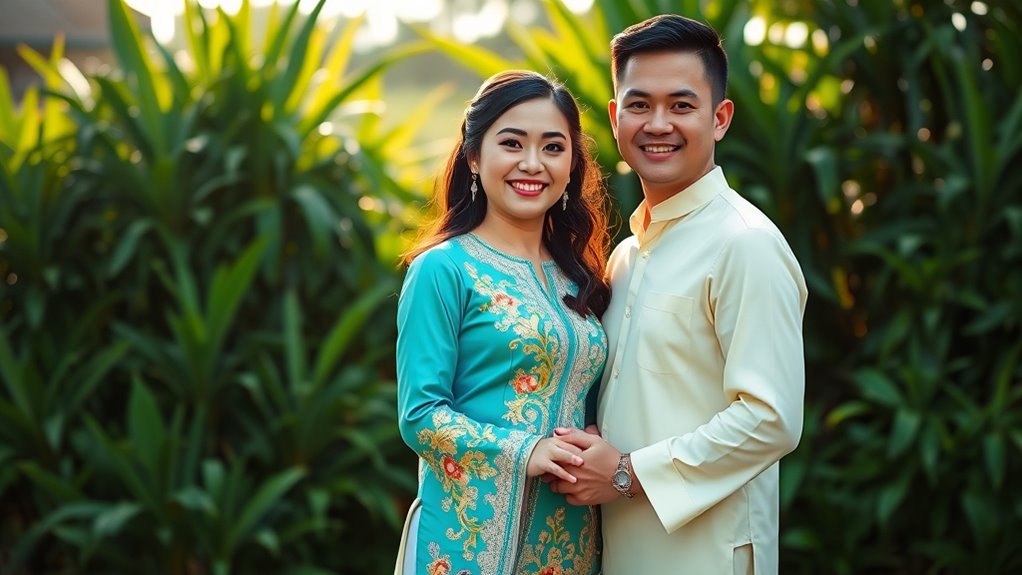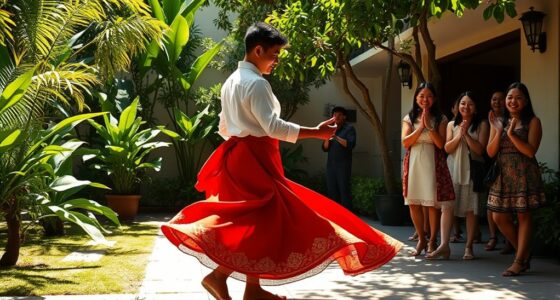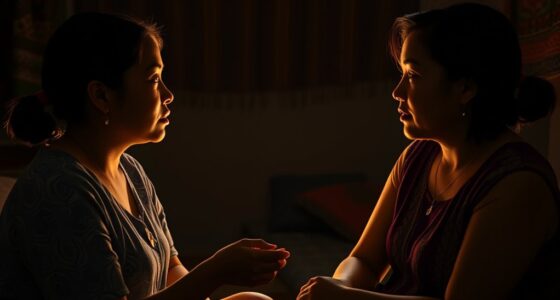Filipino clothing, like the Barong Tagalog and Filipiniana, reflects relationship pride by celebrating cultural heritage and community ties. The vibrant colors symbolize love and unity, while intricate patterns tell stories of family history. Special attire for events strengthens bonds during national holidays and family gatherings, showcasing shared identity. Modern adaptations blend tradition with contemporary style, empowering artisans and fostering connections. There’s so much more to discover about how these garments shape relationships in Filipino culture.
Key Takeaways
- Traditional garments like Barong Tagalog and Terno symbolize cultural pride, reinforcing family and community bonds during celebrations and gatherings.
- Colors and patterns in Filipino clothing express emotions and shared values, reflecting the unity and love within relationships.
- The Maria Clara dress and other traditional attire celebrate historical cultural blends, showcasing the importance of heritage in personal connections.
- Modern adaptations of Filipiniana foster empowerment and pride, encouraging community engagement and preserving cultural identity through local artisans.
- Educational initiatives involving traditional clothing nurture identity in youth, strengthening their connection to heritage and enhancing family ties.
Significance of Filipiniana and Barong Tagalog in Celebrating Relationships

Traditional garments like the Filipiniana and Barong Tagalog play an essential role in celebrating relationships within Filipino culture.
These outfits connect you to your heritage, fostering stronger bonds with family and community. When you wear them during weddings or baptisms, you’re not just honoring traditions; you’re also expressing respect and pride in your cultural identity.
The historical roots of these garments reflect a blend of indigenous and European influences, enriching their significance. Each time you don the Filipiniana or Barong Tagalog, you celebrate family ties and showcase community pride.
The rich history of the Filipiniana and Barong Tagalog reflects a unique blend of cultures, celebrating family bonds and community pride.
This shared cultural experience strengthens relationships, reminding you of the values that unite your family and community, while also preserving a rich legacy for future generations.
The Role of Symbolic Colors in Expressing Love and Unity

Colors play an essential role in expressing love and unity within Filipino culture, as they evoke emotions and symbolize deep connections among individuals.
Red, for instance, symbolizes passion and energy, often showcased during vibrant festivals. White represents purity and unity, making it a staple in ceremonies. The red-brown hues found in traditional textiles connect you to your rich heritage.
Multicolored garments reflect the diversity of Filipino culture, celebrating pride and community spirit. Nature-inspired colors emphasize your bond with the environment, reinforcing shared values.
Whether it’s through symbolic garments or festive attire, these colors create emotional connections, showcasing love and unity that resonate deeply within relationships, blending cultural significance with personal expressions of affection.
Traditional Patterns as a Reflection of Cultural Heritage and Commitment

Garments adorned with intricate patterns speak volumes about Filipino cultural heritage and commitment. When you wear a Barong Tagalog, you’re embracing elegance and modesty, reflecting the rich blend of indigenous and Spanish influences.
The Maria Clara dress, named after a beloved literary character, showcases the fusion of Filipino and Spanish heritage, symbolizing your cultural identity. The Terno, with its iconic butterfly sleeves, evokes national pride and elegance.
Meanwhile, the Tao-Bo headdress highlights the multicultural influences in Mindanao, featuring geometric patterns and Arabic calligraphy. By choosing these traditional garments, you connect with your roots, celebrate your identity, and honor the artistry of Filipino craftsmanship, ensuring that the vibrant patterns and stories behind them live on.
Special Attire for National Holidays and Family Celebrations
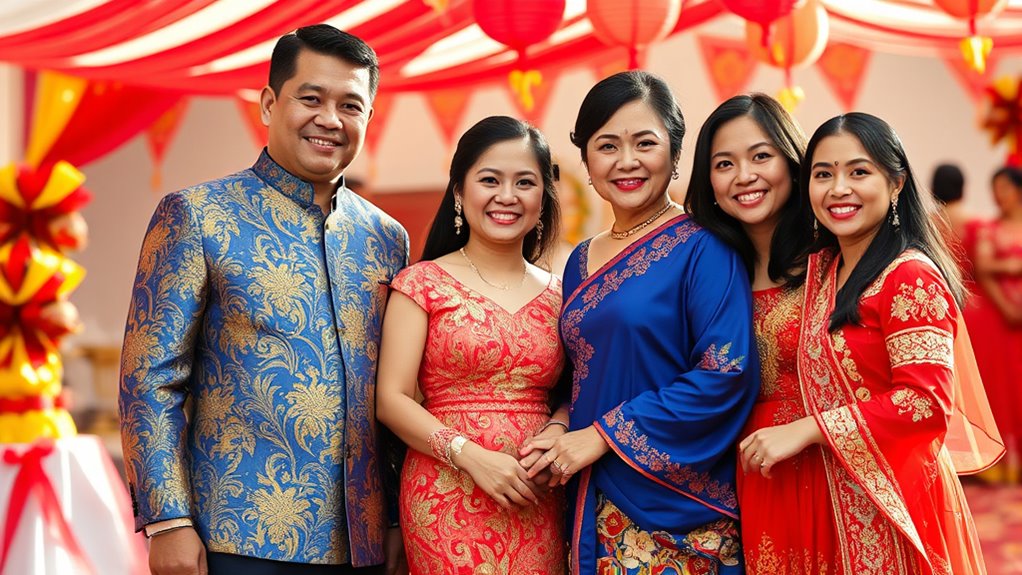
When celebrating national holidays and family gatherings, the choice of attire becomes a powerful expression of your cultural pride and identity. Wearing the Barong Tagalog or the elegant Terno showcases your appreciation for Filipino craftsmanship and heritage.
The Maria Clara dress, a nod to history, reflects the blend of cultures that shape your identity. Donning these traditional outfits during significant events reinforces family bonds and cultural ties.
Additionally, accessories like the Salakot hat symbolize resilience and practicality while adding a distinct touch to your attire. Whether you’re attending a reunion or a national celebration, these garments serve as a reminder of your roots, allowing you to express pride in your heritage and the values that unite your community.
Modern Adaptations: Bridging Tradition and Contemporary Love Stories
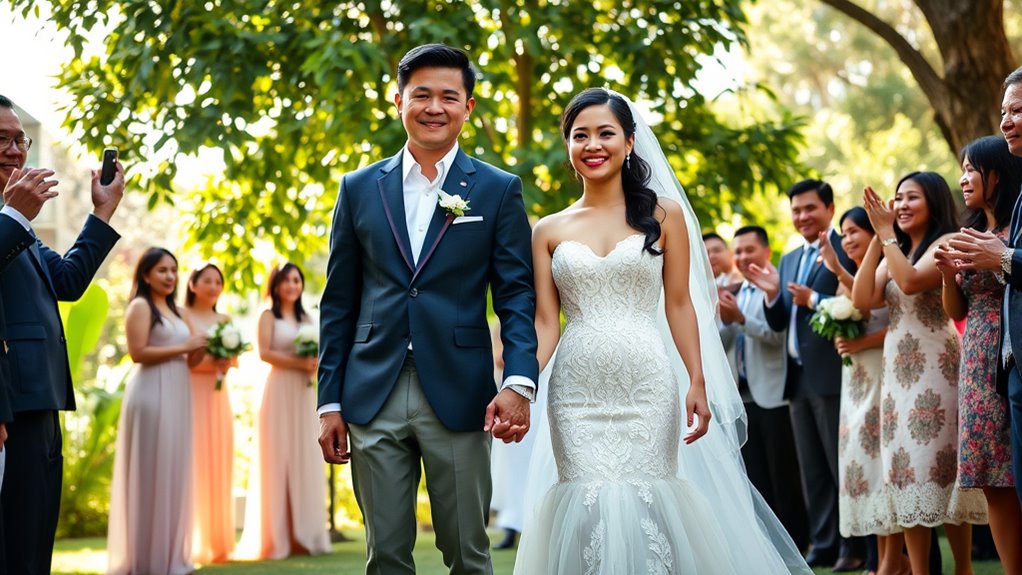
Celebrating your heritage doesn’t stop with traditional attire; it evolves to meet the tastes and lifestyles of today.
Modern Filipiniana blends traditional designs with contemporary aesthetics, featuring sleek silhouettes and minimalist embroidery. This evolution makes the style versatile, appealing to younger generations enthusiastic to honor their roots while embracing modern fashion.
Cultural exchange enriches these adaptations, merging influences from indigenous, Spanish, and American cultures with global trends. Wearing modern Filipiniana allows you to express your identity and pride, connecting with your past while celebrating love and relationships.
Designers often weave personal stories into their creations, making each piece a reflection of contemporary love and shared heritage, transforming fashion into a meaningful expression of your journey.
The Influence of Regional Variations on Relationship Expressions
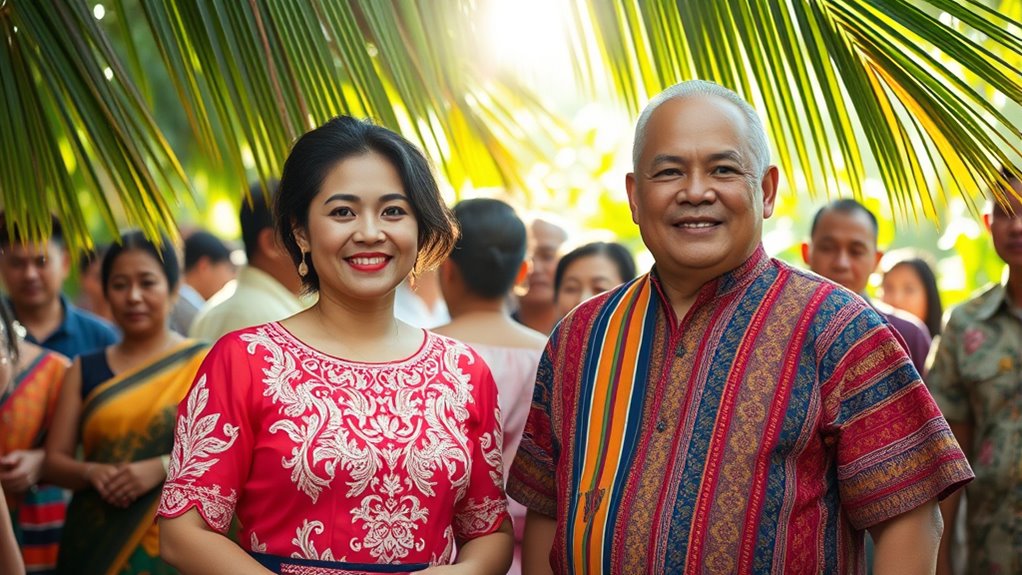
Regional variations in traditional Filipino clothing greatly shape how relationships are expressed and celebrated.
In the Cordillera, the Bahag and Tapis showcase strength through bold patterns, symbolizing deep cultural roots. Meanwhile, the Visayas highlight local craftsmanship with Terno and Kimona, reflecting regional pride during community events like Sinulog.
In the Cordillera, bold patterns of Bahag and Tapis symbolize strength, while Visayas’ Terno and Kimona celebrate local craftsmanship and pride.
In Mindanao, garments such as the Malong and Kegal Tboli resonate with diverse influences, reinforcing community identity. As you engage with these regional styles, you’ll notice how traditional accessories, like beaded necklaces, convey cultural craftsmanship and social norms.
Festivals not only display vibrant costumes but also strengthen community bonds, illustrating how clothing serves as a powerful medium for expressing love and pride in relationships across the archipelago. Additionally, the emphasis on sustainable farming practices in local events mirrors the community’s connection to their heritage and reinforces their relationships with one another.
Celestial Motifs and Their Connection to Family Ties
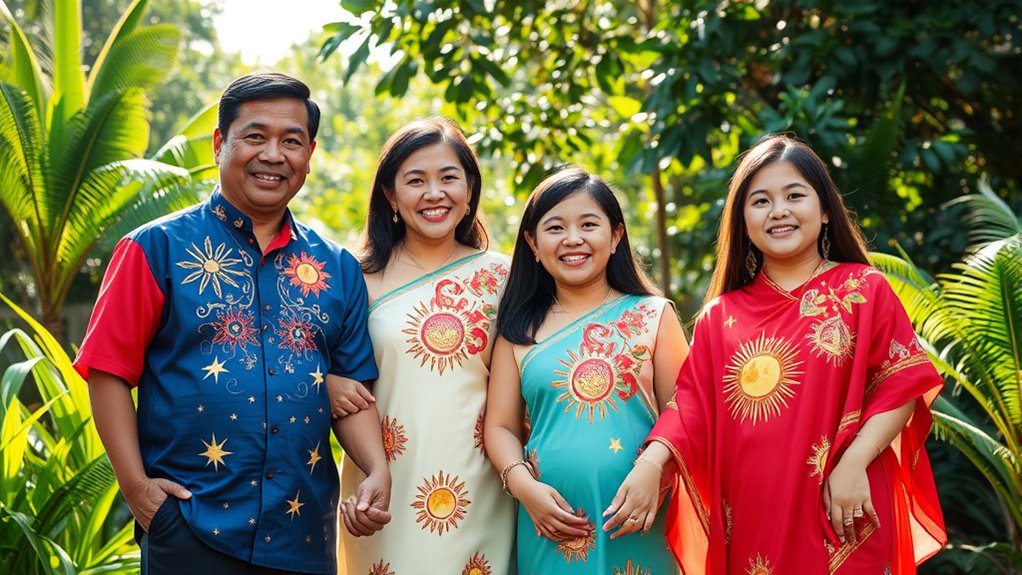
The vibrant expressions of Filipino culture in clothing extend beyond regional variations, as celestial motifs play a significant role in connecting family ties. Incorporating these designs shows respect for ancestors, a core value in Filipino families.
You’ll often find celestial elements blending Christian and indigenous beliefs, symbolizing spiritual connections within familial relationships. Traditional attire, like the *barong tagalog*, features these motifs, emphasizing cultural heritage and pride.
Each celestial design tells a story about your family’s history and community myths, reinforcing your bonds. As you wear clothing adorned with celestial themes, you express hope, love, and unity.
This artistic expression not only honors your roots but also fosters a sense of belonging and shared identity among generations.
The Impact of Colonial History on Relationship Fashion Statements

While colonial history has undeniably shaped Filipino fashion, it also influences how you express relationships through clothing. The blend of indigenous and colonial styles, like the Baro and Barot Saya, reflects cultural identity and pride in your heritage.
These garments often symbolize social status, which can impact how you present yourself in relationships. For instance, wearing traditional attire during special occasions showcases respect for cultural roots and deepens connections with loved ones.
Additionally, adaptations of Western styles, introduced during the American influence, emphasize comfort and practicality in modern relationships. By wearing these symbolic garments, you not only honor your history but also strengthen bonds with those who share your cultural narrative, reinforcing a sense of community and belonging.
Community Engagement Through Clothing: Strengthening Bonds
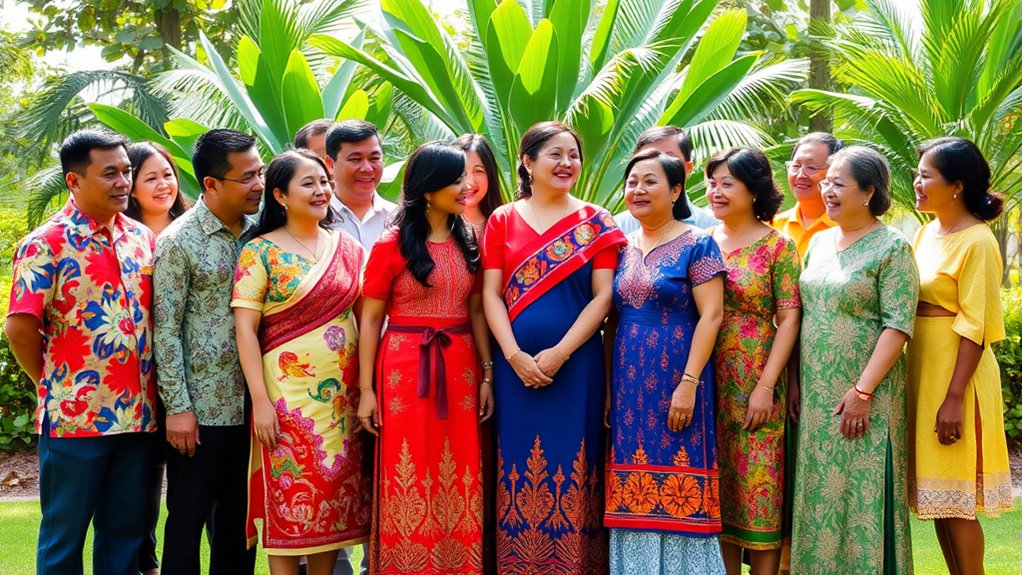
Filipino clothing serves as a powerful medium for community engagement, fostering connections and solidarity among individuals.
By partnering with local artisans, you not only preserve traditional crafts but also boost economic stability within your community. Incorporating Indigenous textiles into modern designs promotes cultural heritage while encouraging sustainable practices. This commitment to halal living practices reflects a broader ethos of social responsibility and respect for diverse cultures. Additionally, supporting such initiatives helps strengthen family caregiving relationships, which are vital in Filipino communities. Many artisans also participate in spiritual retreats that enhance their creative processes and personal growth. Engaging in this collaborative effort can also help individuals overcome fear of being alone by fostering deeper connections and a sense of belonging.
Through collaborative fashion projects, you embody the bayanihan spirit, emphasizing unity and cooperation. Inclusive designs bridge cultural gaps, while social enterprises like Kandama Collective empower local artisans, particularly women weavers.
Fashion events and exhibitions create opportunities to celebrate shared cultural identities, bringing communities together. By engaging with clothing, you help educate others about Indigenous cultures, forging stronger bonds and inspiring collective action that uplifts your community. Additionally, sustainable living practices can be integrated into fashion to further enhance the positive impact on the environment and society.
Education and Preservation: Teaching Future Generations About Relationship Pride
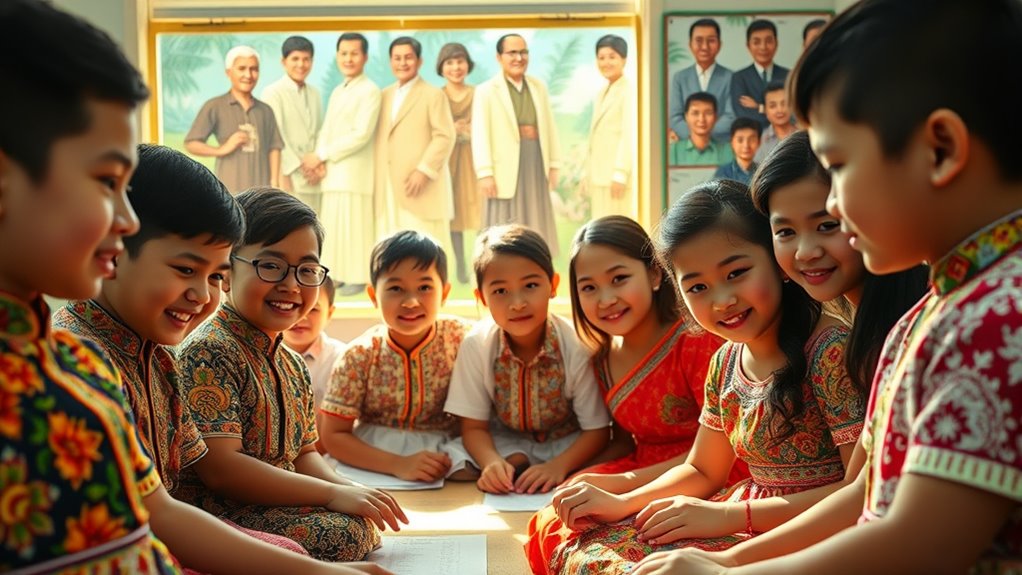
Understanding the significance of traditional Filipino clothing is crucial for nurturing a sense of identity and pride in younger generations. Schools play an important role by incorporating traditional outfits like the baro’t saya and terno into events, helping students connect with their heritage.
Exposure through media and modern adaptations by designers further familiarizes youth with these garments. By developing curricula that highlight the historical context of clothing, students gain a deeper appreciation for their cultural roots.
Participating in cultural events fosters unity, while workshops teach traditional techniques. These efforts guarantee that the pride associated with these garments is passed down, preserving the essence of Filipino culture and identity for future generations.
Frequently Asked Questions
How Do Filipinos Choose Clothing for Romantic Occasions?
When you choose clothing for romantic occasions, you often opt for traditional attire like the Barong Tagalog or Filipiniana dress.
These garments not only showcase elegance but also connect you to your cultural roots. You might select these outfits for formal events or casual gatherings, appreciating their versatility.
What Are Popular Modern Filipino Brands Focusing on Relationship Attire?
If you’re looking for popular modern Filipino brands that focus on relationship attire, you’ve got several exciting options.
Brands like Vinta and Gabbie Sarenas creatively blend traditional and contemporary styles, making them perfect for special occasions.
Kuyate Co. evokes cultural pride in its designs, while Monday Suck offers a casual twist for everyday wear.
These brands not only elevate your wardrobe but also celebrate Filipino heritage, adding a unique touch to your romantic moments.
Are There Specific Colors Associated With Love in Filipino Culture?
In Filipino culture, colors can evoke both the innocence of budding romance and the fiery passion of love.
You’ll find that white sampaguitas symbolize purity, while vibrant hibiscus express deep emotions.
Orchids bring elegance and enduring affection, contrasting beautifully with the loyalty represented by yellow accents.
Each hue carries its own story, blending tradition with modern expressions.
How Does Clothing Impact Filipino Wedding Traditions?
Clothing profoundly impacts Filipino wedding traditions by embodying cultural heritage and identity.
When you choose traditional attire like the Barong Tagalog or Filipiniana, you celebrate your roots and express pride in your heritage.
During ceremonies, these garments enhance the rituals, symbolizing unity and community involvement.
Your fashion choices not only reflect personal style but also honor family ties and ancestral lineage, making your wedding a meaningful cultural celebration.
What Role Do Accessories Play in Expressing Relationship Pride?
Accessories play an essential role in expressing relationship pride. They symbolize bonds, reflect love, and showcase cultural identity.
You wear jewelry like the Anak or Ading necklaces to celebrate family ties and honor connections. You choose traditional pieces that convey elegance while merging modern styles to express individuality.
Conclusion
In embracing Filipino clothing, you celebrate not just personal love but a rich cultural heritage that strengthens community bonds. Each piece, from the elegant Barong Tagalog to the vibrant Filipiniana, tells a story of unity and pride. Isn’t it fascinating how a simple garment can connect generations and reflect deep familial ties? By honoring these traditions, you’re not just wearing clothing; you’re showcasing a beautiful legacy that deserves to be passed down.
